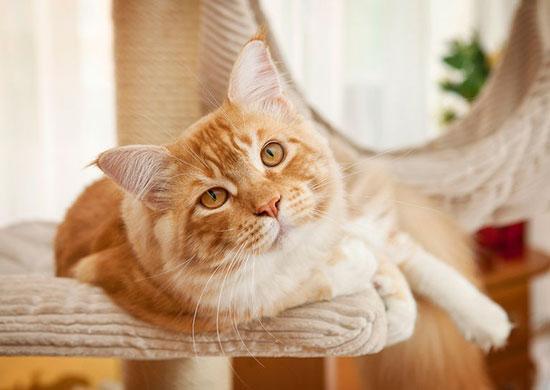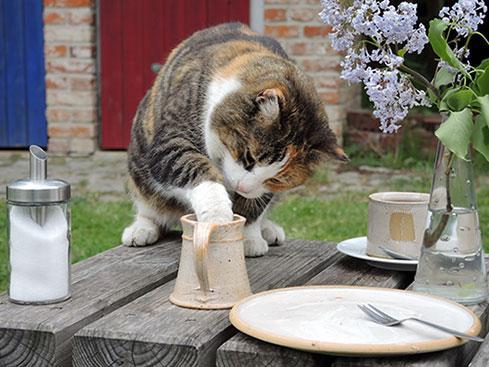This content is archived from the Feline Nutrition Foundation
Calcium Supplements in Homemade Cat Food
- Updated: Sunday, June 02, 2019 02:46 PM
- Published: Sunday, December 03, 2017 12:07 PM
- Written by Marta Kaspar
 Many of you already know that calcium is without a doubt one of the most important nutrients in a cat's diet. It forms healthy bones and teeth, helps in blood clotting, muscle function, nerve transmission and membrane permeability.¹
Many of you already know that calcium is without a doubt one of the most important nutrients in a cat's diet. It forms healthy bones and teeth, helps in blood clotting, muscle function, nerve transmission and membrane permeability.¹
While some raw cat food diets such as whole prey, frankenprey or ground meat with bone generally don't require any supplementation, it's very important to add calcium supplements to all boneless raw meals. Feeding meat without bones or another source of calcium can be disastrous for cat nutrition. It can lead to decreased growth, bone mineralization, decreased appetite, lameness, spontaneous fractures, loose teeth, tetany, convulsions and rickets.² Some of these conditions can become irreversible or even fatal.
So what would be the best supplement for home-prepared boneless raw cat food? There are a few choices; here are the pros and cons for each:
Calcium carbonate (CaCO3)
It's mostly used as ground mineral limestone or eggshell powder. I have to admit that this is my favorite calcium supplement for boneless meat. Pros: It has no taste or odor and can be very low in heavy metals. Another advantage is that it has no phosphorus. That makes it an ideal balancing ingredient for boneless meat which is naturally low in calcium and high in phosphorus. You can also easily make your own eggshell powder if you have a good source of eggshells available. All you have to do is to rinse the eggshells well and bake them approximately 10 minutes at 300 degrees F. Then grind them to make the eggshell powder. See "Feline Nutrition's Easy Homemade Cat Food Recipe" for tips on making your own eggshell powder. Cons: None.
Bone meal (calcium hydroxylapatite Ca10(PO4)6(OH)2)

Pros: A great natural source of calcium, phosphorus and other nutrients. Bone meal can be made at home as a safer option to store-bought products. Cons: Difficult or in some cases impossible to get the right calcium/phosphorus ratio in meat and bone diets. See more about Ca:P ratio below. Bones can be contaminated with heavy metals as many commercial bone meal products are made from older animals. This increases the possibility that the bones have accumulated heavy metals. Note: Don't use bone meal from home or garden stores. These are not intended for consumption and may contain toxic fertilizers.
Calcium bound to lactate, citrate, ascorbate and other organic acids
Pros: It might be more easily and completely absorbed than other supplements, such as calcium carbonate or bones. Cons: It may have an off taste, as all of these supplements are synthetic, not natural.
Let's take a few steps back for a moment and talk about calcium/phosphorus ratio. Using diets with the correct calcium to phosphorus (Ca:P) ratio are essential for proper bone development and maintenance. There are many opinions on what the ideal Ca:P ratio should be, but I think it's reasonable to recommend a range between 1.0 to 1.3 parts of calcium per 1 part of phosphorus. Unfortunately, it may be challenging to get within this range with some whole prey or frankenprey diets. Besides, bones can provide significant levels of calcium and phosphorus in addition to the phosphorus in meat. These diets usually end up with high levels of both calcium and phosphorus, which might be fine for younger cats, but not so great for older cats.
Fortunately, it's easy to calculate accurate Ca:P ratios in supplemented boneless diets. To reach the above recommended range, you would need to add 1000 mg of elemental calcium. That's approximately three grams of eggshell powder to one pound of raw boneless meat. You may want to know how much that is in teaspoons. We don't give it that way because it will measure differently depending on how finely ground the powder is and whether it's freely scooped or packed. It may be less convenient to weigh it, but it's more accurate.
Additional Reading
Answers: Raw Food for Cats, What About Eating Bones?
Answers: Kittens Go Through Teething, Too
Finally, a couple of suggestions: Avoid supplements that contain added vitamin D. Don't over supplement the food. Too much calcium can cause health problems. Other key minerals, such iron, magnesium and zinc, can become depleted in the body when a cat is consuming too much calcium. Excess bone consumption may cause problems leading to stomach discomfort, vomiting or fever. If that happens, contact your veterinarian at once.
Marta Kaspar holds a master's degree in chemistry from the University of Pardubice in the Czech Republic. She's a research scientist, and a formulation and analytical chemist in both industrial and academic fields. Marta became interested in feline nutrition when her cats developed health problems. When she decided to prepare their food herself, the effect of the homemade raw meat diet on her cats was so impressive that she created the line of Alnutrin® supplements to help others transition their cats to better diets. You can find her at knowwhatyoufeed.com.
1. MS Hand DVM, PhD, CD Thatcher, DVM, MS, PhD, RL Remillard, PhD, DVM and P Roudebush, DVM, Small Animal Clinical Nutrition, 4th ed. Walsworth Publishing Company, 2000, pg 71.
2. Karen J. Wedekind, Shiguang Yu, Inke Paetau-Robinson, Christopher S. Cowell, Lauren Kats; Small Animal Clinical Nutrition, 4th ed. Walsworth Publishing Company, 2000, Chapter 6, pg 108.




